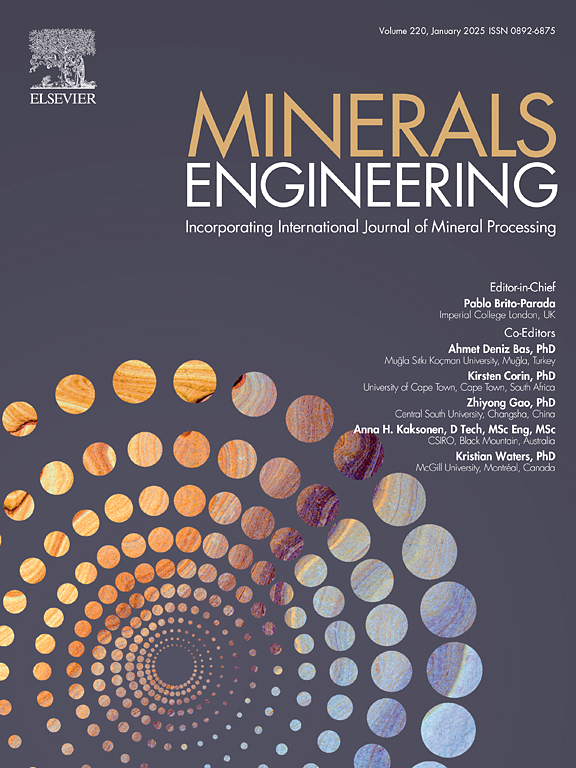Rapid tailings dewatering by flocculation-sedimentation-filtration-microwave sequential treatment
IF 5
2区 工程技术
Q1 ENGINEERING, CHEMICAL
引用次数: 0
Abstract
Achieving low-water-content oil sands fluid fine tailings (FFT) for reclamation is a significant challenge, even with the otherwise effective dewatering methods such as pressure filtration. FFT from mineable oil sands processing comprises high concentrations of clays,which impede its dewatering. This study established a classification of the dominant forms of water in oil sands tailings, namely free water (FW), interstitial pore water (IPW), vicinal pore water (VPW), and surface-bound water (SBW), based on the ease of their removal in dewatering. Most FW and IPW could be removed by sedimentation and filtration following chemical treatment with polymeric flocculants and coagulants. However, removing the VPW and SBW by mechanical dewatering methods was very challenging. Microwave heating was found to be an effective alternative to remove part of the VPW and SBW from filtered FFT or to facilitate subsequent water removal treatment by other less energy-intensive methods, such as air drying. Based on these findings, we propose a concept of an oil sands tailings dewatering process for targeted removal of different forms of water by specific methods. It consists of a sequential chemical treatment of FFT with a flocculant and coagulant, followed by gravity sedimentation and vacuum filtration to remove FW and IPW, generating 50–55 wt% solids filter cakes. This is followed by a microwave treatment with or without subsequent air drying to partially remove the VPW and SBW, achieving ≥65 wt% solids in filter cakes that would be ready for preliminary reclamation activities.

絮凝-沉降-过滤-微波序贯快速尾矿脱水
即使采用压力过滤等其他有效的脱水方法,获得用于回收的低含水量油砂流体细尾矿(FFT)也是一项重大挑战。可开采油砂加工产生的FFT含有高浓度的粘土,阻碍了其脱水。根据油砂尾矿脱水去除的难易程度,建立了油砂尾矿中水的主要形态,分别为自由水(FW)、间隙孔隙水(IPW)、邻近孔隙水(VPW)和表面结合水(SBW)。经高分子絮凝剂和混凝剂化学处理后,大部分FW和IPW可通过沉淀和过滤去除。然而,通过机械脱水方法去除VPW和SBW是非常具有挑战性的。微波加热被发现是一种有效的替代方法,可以从过滤后的FFT中去除部分VPW和SBW,或者促进后续通过其他低能耗方法(如空气干燥)进行除水处理。基于这些发现,我们提出了油砂尾矿脱水工艺的概念,通过特定的方法有针对性地去除不同形式的水。它包括用絮凝剂和混凝剂对FFT进行顺序化学处理,然后进行重力沉降和真空过滤以去除FW和IPW,生成50-55 wt%的固体滤饼。然后进行微波处理,有或没有随后的空气干燥,以部分去除VPW和SBW,使滤饼中的固体含量≥65%,为初步回收活动做好准备。
本文章由计算机程序翻译,如有差异,请以英文原文为准。
求助全文
约1分钟内获得全文
求助全文
来源期刊

Minerals Engineering
工程技术-工程:化工
CiteScore
8.70
自引率
18.80%
发文量
519
审稿时长
81 days
期刊介绍:
The purpose of the journal is to provide for the rapid publication of topical papers featuring the latest developments in the allied fields of mineral processing and extractive metallurgy. Its wide ranging coverage of research and practical (operating) topics includes physical separation methods, such as comminution, flotation concentration and dewatering, chemical methods such as bio-, hydro-, and electro-metallurgy, analytical techniques, process control, simulation and instrumentation, and mineralogical aspects of processing. Environmental issues, particularly those pertaining to sustainable development, will also be strongly covered.
 求助内容:
求助内容: 应助结果提醒方式:
应助结果提醒方式:


